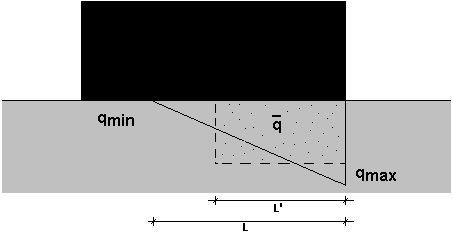Stresses under the foundation calculation results from external loads, the weight of the foundation, and the overlying soils. A linear model, not allowing for tensile stresses in the soil, is applied.

For SNiP 2.02.01-83 and PN-81/B-03020, calculations for the values of average stresses are performed. An average value of stresses is taken into account without considering the zone of zero stresses.

For ACI, BS 8004:1986, CSA, EN 1997-1:2004 and ENV 1997-1:1994 (EC 7), the Take account of plastic redistribution of allowable stresses option may be selected. When ACI is applied, this option is activated by default. It substitutes a stress in the soil with triangular or trapezoidal distribution for the equivalent stress with a rectangular distribution (see 'Foundation analysis and design', Joseph E. Bowles). The is expressed as follows.
where:
ς max ,ς min - Value of the maximal and minimal stress (for the triangular load ς min = 0).
A length of the acting load is calculated from the following.
![]()

For French codes DTU 13.12 and Fascicule 62 Titre V, the formula for the equivalent stress is simplified, however, results comparable to ACI are obtained:
![]() .
.
For multi-layer soils, the stress calculation is conducted for the levels of upper borders of the layers that lie below the foundation. They are carried out analogously as for the soil lying directly under the foundation. The following loads are assumed: foundation loads, a weight of the foundation, weight of the overlying soils, and the weight of the soil from the layers above the upper border of the layer under analysis. The method of calculation of the foundation's equivalent dimensions (scope of impacts, for example),are adopted in the design.

For ACI, BS 8004:1986, CSA, EN 1997-1:2004 and ENV 1997-1:1994 (EC 7), DTU 13.12, and Fascicule 62 Titre V, the following is assumed:
b = h / 2
For SNiP 2.02.01-83 and PN-81/B-03020:
- Cohesive soils

- Non-cohesive soils
 .
.